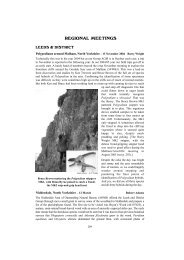Full Contents as pdf File - Natural History Museum
Full Contents as pdf File - Natural History Museum
Full Contents as pdf File - Natural History Museum
Create successful ePaper yourself
Turn your PDF publications into a flip-book with our unique Google optimized e-Paper software.
At 9.45 we moved on, and further down the co<strong>as</strong>tal road came to Lake Quinault Nature Walk<br />
where there w<strong>as</strong> a short loop for gentle walkers and a longer trek ending at the hotel for the<br />
more athletic ones among us. There w<strong>as</strong> a lovely walk through temperate rain forest where the<br />
moss-draped trees, vegetation and fallen trunks were so thick that it would have been<br />
impossible to make progress were it not for the trails prepared for visitors. It w<strong>as</strong> not long<br />
before we took a wrong turn, which w<strong>as</strong> fortunate <strong>as</strong> it led us alongside a pretty little stream<br />
where Adiantum aleuticum decorated the steep sides of the valley. We soon found the right<br />
trail, where Polystichum munitum grew in profusion <strong>as</strong> it does all over this area, with Blechnum<br />
spicant interspersed in the damper patches. Athyrium filix-femina var. cyclosorum and Pteridium<br />
aquilinum var. pubescens were noted again and the oak fern (Gymnocarpium disjunctum)<br />
covered the ground in any clearings. Those who took the longer trail noted Equisetum telmateia,<br />
Lycopodium clavatum and a bifid form of Blechnum spicant growing in some quantity.<br />
Lunch w<strong>as</strong> taken at Lake Quinault Lodge, which w<strong>as</strong> situated on the edge of the lovely<br />
Lake Quinault. Rather more imagination w<strong>as</strong> shown over the lunch, which had an unusual<br />
combination of ingredients in some traditional recipes.<br />
In the short time available before we boarded the bus for the long drive to Kelso, Pat Acock<br />
found both Equisetum fluviatile and E. palustre at the edge of the lake. On the long journey<br />
it w<strong>as</strong> interesting to see how the trees ended when we left the National Park. We ended our<br />
journey at the Red Lion Hotel at Kelso, where we spent the night and some members made<br />
use of the ple<strong>as</strong>ant outdoor swimming pool while others settled into the huge bar area.<br />
Mount St Helens (Friday) Pat Acock<br />
This w<strong>as</strong> an absolute must for the tour. We had lodged within striking distance of the<br />
volcano the night before and reached the first visitor centre early. After looking at the<br />
interpretation displays and watching the short films we started the long drive to the closest<br />
point to the volcano that is accessible by road. Nothing really prepares you for the power<br />
and dev<strong>as</strong>tation caused by one of these cataclysmic events. Two-foot diameter trees<br />
snapped off at waist height five miles from the bl<strong>as</strong>t, and the size of the hole in the side of<br />
the volcano do, however, bring home the reality of it all.<br />
Whilst many took in the sights and looked around the top ranger station, I set off to travel <strong>as</strong><br />
far <strong>as</strong> I could in half the time allotted to see what ferns had colonised the eerie terrain.<br />
Equisetum arvense w<strong>as</strong> the first pteridophyte apparently to be recorded from the area and we<br />
had seen much supporting evidence on the way up, but I w<strong>as</strong> ple<strong>as</strong>ed to find Polystichum<br />
munitum and Athyrium filix-femina var. cyclosorum also making a start. However, the swards<br />
of flowers in some are<strong>as</strong> were breathtaking, especially the paintbrush (C<strong>as</strong>tilleja parviflora),<br />
growing in apomictic clones with bracts ranging from vermilion to cerise to magenta.<br />
Too soon we were on our way back. Our evening w<strong>as</strong> to be spent at a celebration dinner in the<br />
penthouse restaurant of Lyman Black’s apartment complex and we had to cover some distance.<br />
At dinner, Graham Ackers kindly led the vote of thanks to the large number of helpers who<br />
had made the excursion possible but principally to Sue who had organised the tour to<br />
perfection, putting in hours and hours of planning and discussions to finally come up with just<br />
that right balance of gardens and field meetings that really w<strong>as</strong> the ‘Best of the West’.<br />
We then had a chance to look around Lyman’s fern garden with the waters of Lake W<strong>as</strong>hington<br />
gently lapping all around, before finishing the tour with a lecture and slide presentation by<br />
Martin Rickard on some of the best fern gardens he knows. We then had to say our final<br />
goodbyes, but not before Jerry Little, our coach driver for most of the tour, made a small speech.<br />
Jerry had played no small part in making sure that we were comfortable throughout the hot<br />
weather that accompanied the trip and with his cheery good nature kept us amused and ‘on t<strong>as</strong>k’.<br />
We hope that the friendships and contacts made during the tour will develop into mutual<br />
support and understanding of each other and generally further our aims to develop the<br />
interest and conservation of our beloved ferns.<br />
108

















